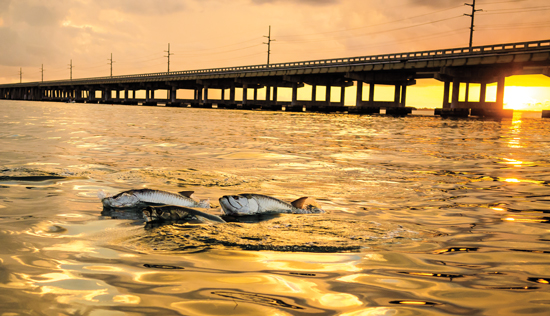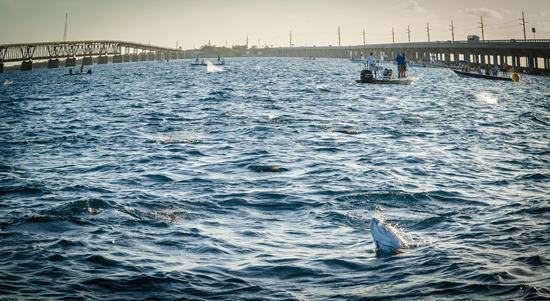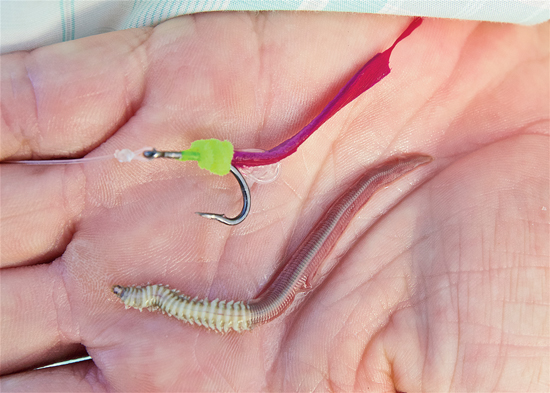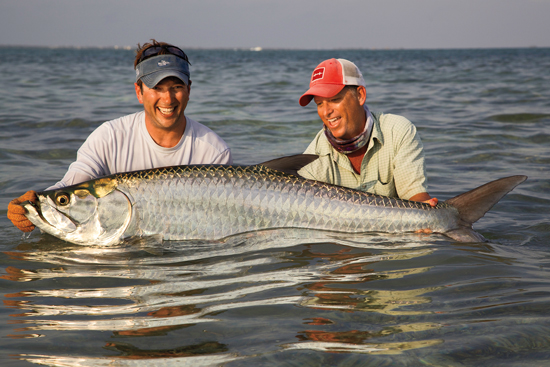
Florida Keys tarpon feast on migrating palolo worms, and they depend on the glut of protein to fuel their own spawning shortly afterward. Photo ❱ Capt. Joel Dickey
Florida’s insane palolo worm hatch
Whether you’re dreaming about the world-famous salmonfly bonanza that sends Madison River rainbows into a frenzy, or a nighttime Hex emergence that brings otherwise reticent Michigan browns to the surface, nothing gets fly fishers more pumped than the thought of finding that singular moment when big fish simply lose their inhibitions due to a prolific food source.
Hitting the hatch
Whether it is the sockeye salmon egg drop on a wild river in Alaska, or an East Coast menhaden run—is what fly fishing is all about. The term “hatch” most commonly refers to freshwater emergences of aquatic insects, but fly fishers have also adopted it to mean any highly anticipated and abundant food source.
For most trout fishers, the aquamarine colors, warm weather, breath-taking beauty, and large fish of Florida’s shallow saltwater flats are exciting any time. But for serious saltwater fly fishers—and for locals who haunt these flats all year—the highlight of the season is the palolo worm hatch.
When the whispers of the first palolo worm sightings hit the radio, even the most callous veterans become wide-eyed and sweaty as a surge of adrenaline builds an uncontrollable level of excitement. They know it’s time to cowboy up, because all hell is about to break loose.
Licorice Sticks
Witnessing a lion pride stalking and taking down a Cape buffalo, or a school of sailfish strategically working a bait ball, leaves any observer amazed. In the wild it’s a common and necessary part of life, but for us to experience it firsthand is a rare privilege. Fly fishers who are fortunate enough to witness a palolo worm hatch are often equally transfixed. Even if you don’t manage to land a fish, it’s a feeling of shock and awe that won’t soon be forgotten.
There is a reason why most fly fishers haven’t seen this natural phenomenon—like most famous hatches, it’s all about the timing. And with weather, tides, moon phase, and other factors influencing the hatch, it’s difficult to predict. The peak worm event is usually only one or two evenings out of the entire year, but when conditions are prime, the tarpon get just as excited about it as fly fishers do. It’s the only time in the Florida Keys when you can find acres of rolling tarpon feeding on or near the surface.

When the palolo worm hatch goes off sometime near the May full moon, all hell breaks loose in the tidal bottlenecks where the worms migrate, and tarpon gather to feed on them. The worms use darkness to camouflage their race to the reef, so the best fishing is often in the late afternoon and evening. Photo ❱ Capt. Joel Dickey
There isn’t much scientific information out there specifically on Atlantic Ocean palolo worms. They have no commercial value, and have been mostly ignored by the scientific community. There have been some studies on similar palolo worms in the Pacific Ocean that look similar. I certainly am not qualified to give a scientific breakdown of these little red tarpon licorice sticks, but what I can do is share my 24 years of observations and experiences fishing these hatches throughout the entire Florida Keys.
With over 14 different species of palolo worms verified globally, hatches occur in most warm tropical waters with important identified hatches in Samoa, Micronesia, Fiji, the Cook Islands, and Tonga in the fall, and Indonesia in the spring. I have witnessed worm hatches in the Florida Keys anywhere from early May to July.
Hatches worldwide seem to have a strong relation to the lunar cycle. However, I believe that in the Keys, what triggers the worm hatch has more to do with the strength and timing of the water flow, more than any specific lunar phase (although the two are related). During late spring and early summer the Keys have some of the strongest moving tides of the year.
Pacific palolo worms release their eggs and sperm together at the surface, creating a large milky fertilization cloud. It’s during this time that local villagers scoop up the worms in homemade nets and have an annual festival where they either boil, fry, or bake the worms into a loaf with coconut milk and onions or create a spread served on toast or crackers like caviar. Since the worms are loaded with protein, it’s no wonder why they are such a sought-after food source on these tropical islands.
The name palolo is derived from the Samoan name meaning green. Male worms seem to have a rusty brown color body with a pinkish tan colored head, where the females might look to have a head that is greener or a hint of chartreuse with more of a reddish pink body.
The Keys worms seem to be born with built-in micro afterburners that wiggle along their head quickly propelling them through the water at an impressive pace. After they emerge from their sandy burrows, they all seem to head directly toward the offshore reef system that lines the entire Atlantic side of the Florida Keys.
The Keys reef is the third largest reef system in the world. Only Australia’s Great Barrier and Belize’s Barrier reefs are larger. Many of the fish that inhabit the Florida Keys also spawn on or around this reef system. Coincidence? Probably not.
The nearby Gulf Stream supplies the reef with a constant supply of oxygenated, nutrient-rich water that makes up a perfect reproduction habitat for marine life. When the worms hatch they most frequently ride the coattails of the strongest falling tides of the year to help them get to the reef even faster and hopefully safer.
About 11 years ago, my son BJ and I were having fun digging a deep hole at a beach at Bahia Honda State Park. At that time I had seen plenty of worms, but they were all free-
swimming worms about 2 to 4 inches long, with little pink or tan heads and a red to pink color body. When we dug that hole in the sand, every scoop of sand had numbers of 10-inch-long red worms that looked just like overgrown palolo worms.
I have since learned that these worms live mostly in hard coral bottoms, and are normally 8 to 12 inches long when their egg and sperm sacs are mature. When conditions are right, these sacs start to wiggle and break free (or hatch) from the main body, and rapidly start swimming out to the reef where they will (when the time is right) release their eggs and sperm to start a new generation of worms.
The worms that swim to the reef are like detachable lunar modules. The rest of the worms are homebodies that start to grow another reproductive section that will separate yet again next year. Like acorns falling from trees to feed the deer, palolo worms provide Keys tarpon a dependable and renewable protein source to sustain them. It’s one of the most important and dynamic links in our tarpon fishery, yet most people know little about it.
There seems to be no shortage of worms. Many Keys guides (myself included) believe that the tarpon get some sort of protein overload by gorging themselves on these worms, as they have a tendency to disappear for two or three days immediately after the peak of the hatch. Hmmm.
Many other living creatures need an abundance of protein to trigger their own reproductive behaviors. If this is true with the tarpon, then this would explain the absence of tarpon at times right after the hatch. They are on the reef spawning.
I always wondered why these giant fish go crazy gorging on these worms, but now I totally get it. The tarpon love to eat these worms but they also need them in their diet to successfully mate and propagate their own species. And since tarpon are known to reproduce offshore, this combination of their disappearance and the main worm hatch makes total sense.
Raining Cement Trucks
During the hatch, it’s common to watch a tarpon roll super slow while slurping a worm, then sink sideways followed by huge tail slap that douses anything nearby. Every once in a while you see a burst of energy that launches a fish up out of the water like a roman candle. When one fish jumps, it often lands right on top of another school and sends those fish exploding in a domino effect across the flats. These aren’t trout sipping at the surface, they sound like cement trucks falling out of the sky.

Palolo worms are 2 to 4 inches long with rust/red/pink bodies and green or tan heads. Simple flies made from chenille and marabou imitate the shape and movement of migrating worms. Photo ❱ Pat Ford
This widespread feeding commotion makes it difficult for fly fishers to focus on making just one cast and presentation at a time. Too often I see fly fishers make a perfect presentation to a group of worming tarpon, then as they are starting to swim the fly, they see another fish closer, but off to the side. So they frantically pick up the fly to make another cast to the closer fish, but this pulls the fly away from the original group of feeding tarpon.
Meanwhile, the fly is in the air instead of in the water, and quick change-of-direction casts often introduce an uncontrollable amount of slack in the casting system which causes tangles and even more time lost and frustration.
Slow down. Take a deep breath. Pick one target, and fish each cast all the way to the boat. Most bites seem to occur where you don’t exactly see the fish showing on the surface. So keeping the fly in the water more results in more bites.
I helped Airflo design the Tropical Punch floating line, and it’s my most frequently used line during the worm hatch. The surface of the water is an obvious travel lane for worms and that’s where you see tarpon feeding, but wherever there are worms on the surface, you can be confident they are at all depths.
It’s really easy to get mesmerized by the seemingly endless surface slurping circus display, but another whole level of worm carnage is happening beneath the surface. Intermediate and sinking lines can get you out of the way of floating weeds, cut the wind, and depending on the current can help slow down the fly for longer presentations. Sometimes the fish that are not showing on the surface are more comfortable and seem to be feeding even more aggressively.
Timing is Everything
Most people believe that the peak of the worm hatch coincides with the full moon in May. But that’s only true if a number of other critical components all come together, and usually they don’t all come together on the expected moon phase. I believe it all has to do with the strength and timing of the tide or current flow.
Since the low tides are much lower than normal this time of year, that means there is a lot more water that needs to be flushed out within a single tide. This makes the current flow extreme. The worms have to make it to the reef quickly and safely to survive and spawn. The stronger the water flow, the faster the worms can get to the reef.
The worms are fairly small, and they are likely difficult to see in low light, which is why most hatches develop later in the evening. Maybe that’s also why tarpon have such large eyes and well-developed nocturnal vision.
Sometimes you’ll find a flat with tons of worms moving, and just a few fish—those are the times it can be tough to get a hookup even though you plainly see fish feeding. Other times there are lots of fish around, and just enough worms to keep them interested. This scenario often turns into a tarpon-launching festival. Whenever you have more fish than food, and the fish are looking for and anticipating a feast, it’s game on.
Sometimes I find some sort of a worm hatch from 20 minutes up to a few hours every night up to four to six nights in a row as long as conditions are favorable. The peak is easy to recognize as all hell breaks loose for many hours and there are endless worms and fish for miles.
Whenever conditions are right, the fish start to act like the worms are actually hatching even though from our vantage point there may be no worms . . . or very few of them anyway. Lots of fish acting wormy—but no worms—usually equals a quick hook-up. These conditions are hard to luck into so you have to go every night for weeks to make sure you don’t miss out.
Location is Everything
The best spots for worm hatches are all similar. There needs to be hard-bottom flats, super strong water flow, and nearby deep water. Often, the fish will tell you where the best worm habitat is. These are long-lived fish, and they’ve been feeding on these worms for years. The ’poons know when and where the worms are getting ready to hatch and they stack up in these spots in anticipation. This is where the deeper water comes into play. More water depth usually equals more fish.
These prime worm habitats are abundant throughout the entire Florida Keys, and you can find tarpon feeding on worms throughout the ocean side of the Florida Keys from Key Largo all the way to Key West. Anywhere there is a bridge and a view of the ocean is a potential location for a successful palolo worm hatch. The bridges generally cross over narrow bottlenecks with exactly the right kind of depth and flow for successful evening on the water.
Getting Hooked Up
You might think with the incredible visual display of psychotic worm carnage that you couldn’t go wrong with any presentation or fly choice. Just get the fly in the water and you are hooked up, right? Sometimes that’s the case, but other times the tarpon can be surprisingly finicky.
Some people believe that the tarpon are “selectively” preferring to eat real worms over your worm fly because they can discern the differences. But I refuse to believe that tarpon are so smart that when they are engulfed in a worm feeding frenzy with hundreds of their buddies, they can pick out and choose to eat only a natural. Choppy surface water, ripping current, and all kinds of floating grass mixed in with the worms makes it tough for the tarpon to even find a worm. Tarpon have to deal with all of these factors while swimming at a fast clip in visually difficult low-light conditions.
All of these factors help to hide the fact that your fly is not real, and should increase the odds of a bite, not decrease them. There is no way they are refusing your fly and instead choosing a natural worm. There are other reasons for what seems to be a lack of interest in your fly.
In these circumstances, they don’t eat the fly because the appearance of it doesn’t time exactly right with their worm gulps. When the worms are thick, there is no need for a fish to specifically search for a single fly. Tarpon are lazy, and when the worms are thick they can just open their mouths and slurp whatever is there. No extra movements or energy are needed. Don’t worry, your fly is not the only worm not getting eaten. Plenty of them survive. The fish just swim along knowing that all they have to do is eat anything that ends up right in front of their mouths.
In my mind, the primary obstacle to hooking a tarpon is getting the fish to actually see the fly. Imagine the odds of a fish seeing your fly in the middle of thousands of other real worms and tons of floating sea grass. The tarpon are often swimming shoulder to shoulder with each other, which creates tight feeding formations, and forces each individual fish to focus on a small feeding lane, which reduces the odds of each individual fish seeing your fly.
If that’s not enough to hinder the odds, try factoring in high winds that create a sloppy quick-shifting surface mixed with grass, worms, and frothing foam. Meanwhile the fish can be constantly changing directions, which creates difficult and shifting light angles.
Combine all these uncontrollable conditions with a strip that’s too fast (which is easy to do with coinciding strong tidal currents) and you’re in and out of the fish’s vision in a split second.
This is when your angling ability comes into play. A good fly fisher constantly knows where the fly is in relation to the fish, and is able to adapt the retrieve based on the direction of the current to keep the fly swimming in front of feeding fish for as long as possible.
Many fly fishers like to “match the hatch” by casting upcurrent, and stripping the fly quickly downcurrent to imitate the direction of travel of most of the worms. While it’s true that the worms are mostly swimming with the current, not against it, I believe that if your fly is doing what all the other worms are doing, then it just blends in.

Capt. Bruce Chard (right) has witnessed 24 seasons of Florida Keys worm hatches. Photo ❱ Tony Weaver
Applying totally different presentation techniques that don’t match the hatch can make your fly stick out like a sore thumb. Remember . . . just get the fish to see the fly. The fish is already in an aggressive feeding mood, take advantage of that. More times than not, the fish won’t think twice about trashing your fly.
Palolo worms swim fast enough on their own let alone when riding hard with the ripping current. You have to imagine that fish are tired of watching worm after worm go by that they can’t catch. The second a fish has the chance to lock in on a worm (or your fly) that’s not moving very fast, it’s game on. Fish are dumb, especially when they are entranced in a worm feast.
So try different presentations where the fly is swimming across-current at an angle. Like “swinging for steelhead” you’ll cover a wide swath of water, moving the fly in front of many unseen fish. And if you plan it right you can swing/swim your fly to intersect with a gulping/rolling train of tarpon. Just as in a river, you can mend the line upcurrent to slow the progress of the fly, and mend downcurrent to speed it up. Stripping the fly faster just means you’ll have to cast more frequently.
You’ll need to work with the wind, current, and the direction the fish are traveling to create a noninvasive presentation, and by that I mean the fly should not swim directly at the tarpon. The angle between the direction of travel and the direction the fly is moving should be as small as possible.
Worm Flies
There are a number of different worm flies on the market today. All will likely catch fish in the right conditions. As with all tarpon flies you need a fly that doesn’t foul—you shouldn’t need to fix or inspect your fly after each cast—and you need a strong, sharp, dependable hook.
It’s important that your fly shows a realistic profile, and to a lesser degree, the right size. Palolo worms are thin with a wiggly tail. Keeping your worm flies simple is the key.
A simple single rabbit strip or small marabou feather can cover all of these needs with ease. Wet marabou forms a perfect small worm profile, and we all know how well it wiggles in the water.
Red, orange, pink, and rust marabou all seem to work well with a pink, chartreuse, olive, or tan chenille head. You can fill your fly box in no time with these simple worm flies in various colors.
With good timing, a fly box full of yummy ’poon candy, some angling creativity, and a little luck you can take full advantage of your palolo worm hatch opportunities. Create your own luck. Become a worm hunter and put yourself in position to witness the most incredible hatch of all. I’ll see you out there!
Bruce Chard has been a Florida Keys guide for 24 years. This issue marks the fourth time he has been on the cover of Fly Fisherman (previously in 1998, 2011, and 2012).
The post Tarpon Caviar appeared first on Fly Fisherman.
Leave a Reply